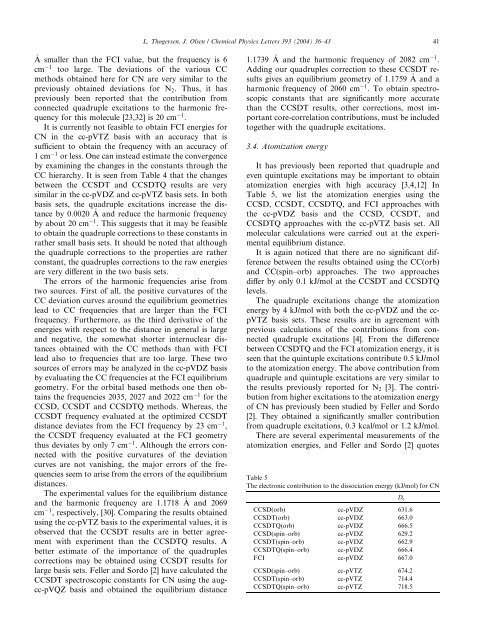Get my PhD Thesis
Get my PhD Thesis
Get my PhD Thesis
You also want an ePaper? Increase the reach of your titles
YUMPU automatically turns print PDFs into web optimized ePapers that Google loves.
L. Thøgersen, J. Olsen / Chemical Physics Letters 393 (2004) 36–43 41<br />
A smaller than the FCI value, but the frequency is 6<br />
cm 1 too large. The deviations of the various CC<br />
methods obtained here for CN are very similar to the<br />
previously obtained deviations for N 2 . Thus, it has<br />
previously been reported that the contribution from<br />
connected quadruple excitations to the harmonic frequency<br />
for this molecule [23,32] is 20 cm 1 .<br />
It is currently not feasible to obtain FCI energies for<br />
CN in the cc-pVTZ basis with an accuracy that is<br />
sufficient to obtain the frequency with an accuracy of<br />
1cm 1 or less. One can instead estimate the convergence<br />
by examining the changes in the constants through the<br />
CC hierarchy. It is seen from Table 4 that the changes<br />
between the CCSDT and CCSDTQ results are very<br />
similar in the cc-pVDZ and cc-pVTZ basis sets. In both<br />
basis sets, the quadruple excitations increase the distance<br />
by 0.0020 A and reduce the harmonic frequency<br />
by about 20 cm 1 . This suggests that it may be feasible<br />
to obtain the quadruple corrections to these constants in<br />
rather small basis sets. It should be noted that although<br />
the quadruple corrections to the properties are rather<br />
constant, the quadruples corrections to the raw energies<br />
are very different in the two basis sets.<br />
The errors of the harmonic frequencies arise from<br />
two sources. First of all, the positive curvatures of the<br />
CC deviation curves around the equilibrium geometries<br />
lead to CC frequencies that are larger than the FCI<br />
frequency. Furthermore, as the third derivative of the<br />
energies with respect to the distance in general is large<br />
and negative, the somewhat shorter internuclear distances<br />
obtained with the CC methods than with FCI<br />
lead also to frequencies that are too large. These two<br />
sources of errors may be analyzed in the cc-pVDZ basis<br />
by evaluating the CC frequencies at the FCI equilibrium<br />
geometry. For the orbital based methods one then obtains<br />
the frequencies 2035, 2027 and 2022 cm 1 for the<br />
CCSD, CCSDT and CCSDTQ methods. Whereas, the<br />
CCSDT frequency evaluated at the optimized CCSDT<br />
distance deviates from the FCI frequency by 23 cm 1 ,<br />
the CCSDT frequency evaluated at the FCI geometry<br />
thus deviates by only 7 cm 1 . Although the errors connected<br />
with the positive curvatures of the deviation<br />
curves are not vanishing, the major errors of the frequencies<br />
seem to arise from the errors of the equilibrium<br />
distances.<br />
The experimental values for the equilibrium distance<br />
and the harmonic frequency are 1.1718 A and 2069<br />
cm 1 , respectively, [30]. Comparing the results obtained<br />
using the cc-pVTZ basis to the experimental values, it is<br />
observed that the CCSDT results are in better agreement<br />
with experiment than the CCSDTQ results. A<br />
better estimate of the importance of the quadruples<br />
corrections may be obtained using CCSDT results for<br />
large basis sets. Feller and Sordo [2] have calculated the<br />
CCSDT spectroscopic constants for CN using the augcc-pVQZ<br />
basis and obtained the equilibrium distance<br />
1.1739 A and the harmonic frequency of 2082 cm 1 .<br />
Adding our quadruples correction to these CCSDT results<br />
gives an equilibrium geometry of 1.1759 A and a<br />
harmonic frequency of 2060 cm 1 . To obtain spectroscopic<br />
constants that are significantly more accurate<br />
than the CCSDT results, other corrections, most important<br />
core-correlation contributions, must be included<br />
together with the quadruple excitations.<br />
3.4. Atomization energy<br />
It has previously been reported that quadruple and<br />
even quintuple excitations may be important to obtain<br />
atomization energies with high accuracy [3,4,12] In<br />
Table 5, we list the atomization energies using the<br />
CCSD, CCSDT, CCSDTQ, and FCI approaches with<br />
the cc-pVDZ basis and the CCSD, CCSDT, and<br />
CCSDTQ approaches with the cc-pVTZ basis set. All<br />
molecular calculations were carried out at the experimental<br />
equilibrium distance.<br />
It is again noticed that there are no significant difference<br />
between the results obtained using the CC(orb)<br />
and CC(spin–orb) approaches. The two approaches<br />
differ by only 0.1 kJ/mol at the CCSDT and CCSDTQ<br />
levels.<br />
The quadruple excitations change the atomization<br />
energy by 4 kJ/mol with both the cc-pVDZ and the ccpVTZ<br />
basis sets. These results are in agreement with<br />
previous calculations of the contributions from connected<br />
quadruple excitations [4]. From the difference<br />
between CCSDTQ and the FCI atomization energy, it is<br />
seen that the quintuple excitations contribute 0.5 kJ/mol<br />
to the atomization energy. The above contribution from<br />
quadruple and quintuple excitations are very similar to<br />
the results previously reported for N 2 [3]. The contribution<br />
from higher excitations to the atomization energy<br />
of CN has previously been studied by Feller and Sordo<br />
[2]. They obtained a significantly smaller contribution<br />
from quadruple excitations, 0.3 kcal/mol or 1.2 kJ/mol.<br />
There are several experimental measurements of the<br />
atomization energies, and Feller and Sordo [2] quotes<br />
Table 5<br />
The electronic contribution to the dissociation energy (kJ/mol) for CN<br />
CCSD(orb) cc-pVDZ 631.6<br />
CCSDT(orb) cc-pVDZ 663.0<br />
CCSDTQ(orb) cc-pVDZ 666.5<br />
CCSD(spin–orb) cc-pVDZ 629.2<br />
CCSDT(spin–orb) cc-pVDZ 662.9<br />
CCSDTQ(spin–orb) cc-pVDZ 666.4<br />
FCI cc-pVDZ 667.0<br />
CCSD(spin–orb) cc-pVTZ 674.2<br />
CCSDT(spin–orb) cc-pVTZ 714.4<br />
CCSDTQ(spin–orb) cc-pVTZ 718.5<br />
D e

















